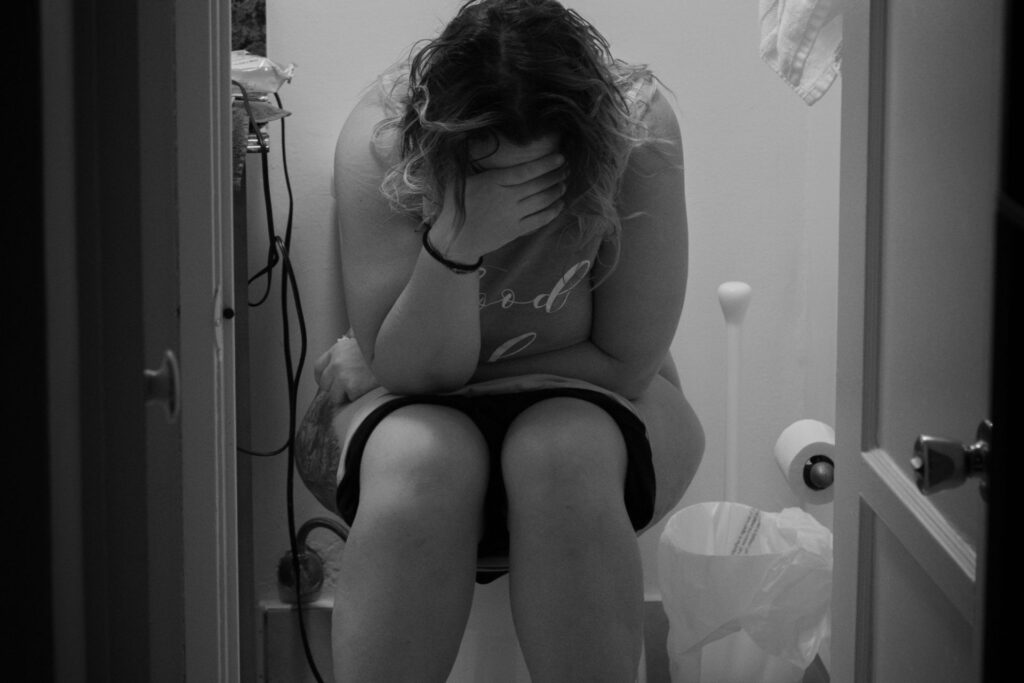Birthing is as varied and unique as women themselves. Yet, women have traditionally adopted common positions in labour. Most women remain upright and moving early on, leaning forward with contractions. As bearing down approaches, women tend to get closer to the ground: kneeling, squatting or moving onto all fours.

- Being upright and mobile encourages progress, increases the efficiency of contractions and eases the rotation and descent of a well positioned baby. It is usually much more comfortable, and improves circulation for mom and baby.
- Lying down, especially on the back, is rarely chosen spontaneously. It constricts the pelvis, which can lead to less optimal positions of a baby. It decreases blood flow, is more painful, and can slow progress, all of which increases the likelihood of interventions.
Early Labour
This is the time to be up and moving. Vary your positions and alternate rest with activity to help labour progress. Try walking, rocking, swaying, circling your hips (hula hoop) or doing the pelvic tilt. All help open the cervix and move the baby down. Lean forward on a table, countertop or your partner. If your legs are tired, alternate by sitting on an exercise ball or backward on a chair, or kneeling on a padded surface, supported by pillows.
Bearing Down
It is beneficial to remain upright, using gravity. Try standing, using a pole or rope to pull on, sitting on a birth stool, exercise ball, or bed, squatting with your partner's help, supported kneeling, or crouching on all fours. These positions facilitate the opening of the pelvic outlet, the last diameter your baby passes through on the journey. The tailbone can move freely out of the way, and the vaginal and perineal tissues stretch and open unimpeded.
The Big Arrival!
Finally, your baby emerges! Most women need a moment at this point. There is a natural sequence of events where, if unrestricted and unforced, mothers will take a small breather. Then, they look at their baby, touch gently, and progress into caressing and stroking. Finally moms can move into position so they can pick up their baby and offer the breast. Upright positions, especially while nursing, encourage your placenta to deliver spontaneously.
Special Circumstances
There are sometimes challenges in labour that affect your ability to move freely and spontaneously. The use of electronic fetal monitoring (EFM) restricts your movements, and may keep you confined to lying down in bed.
If you are on EFM, there are many creative ways to use it while promoting your free movement. For example, your midwife, doula, partner or nurse can hold the transducer (which is placed on your abdomen to pick up the heartbeat) in place while you move. The belts can be adjusted if you change positions. The unit can be moved to follow you elsewhere in the room, for example as you lean on a counter, or sit on the toilet. You can ask that the monitoring be interrupted to allow for periods of walking, or being in the bath or shower.
If your pregnancy is complicated by pre-existing conditions or risk factors, such as hemorrhage or high blood pressure, your caregiver may suggest a specific position for the birth.
Discuss your options and preferences fully with your midwife or doctor during pregnancy. If you have nursing care during your labour, talk to them early about your choices. Given the chance to feel safe and supported, to move around freely, and adopt any position you choose, you will naturally follow your body's guidance and opt for the perfect position at the perfect time.
Under Water
Water during labour can offer great relief, promote rest and relaxation, decrease pain, and speed up labour, decreasing the need for pain medications or interventions.
- Shower: Direct the spray onto your back while sitting or kneeling, or try an exercise ball. It is great for being alone, to concentrate, relax, and focus on your labour.
- Bath: A bath will often slow early labour, but speed it up later. A bath offers all-over comfort and warmth, promotes circulation and calms you.
- Water birth: Some women choose to stay in the bath for the birth. There is evidence to support water birth as safe for both mothers and babies. Proponents argue that water births are easier and gentler, leading to better initial responsiveness of babies, less need for analgesia and other interventions, and fewer injuries to vaginal tissues. Many birthing units around the world have the option of water birth available for mothers. Talk to your caregiver about this option.










